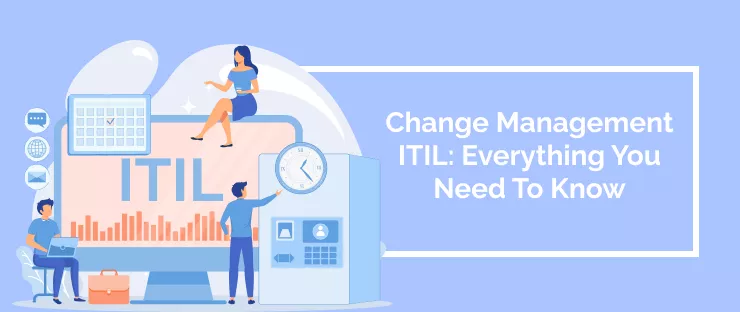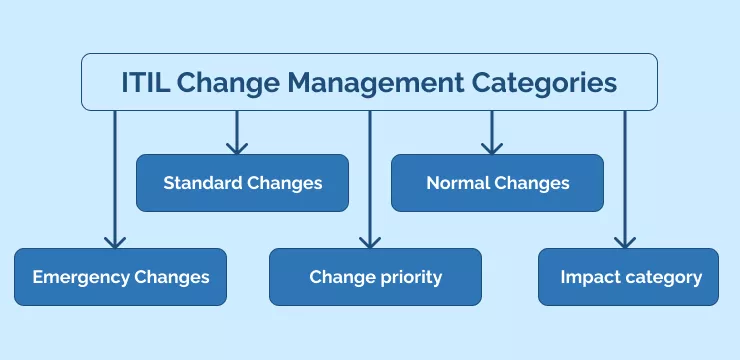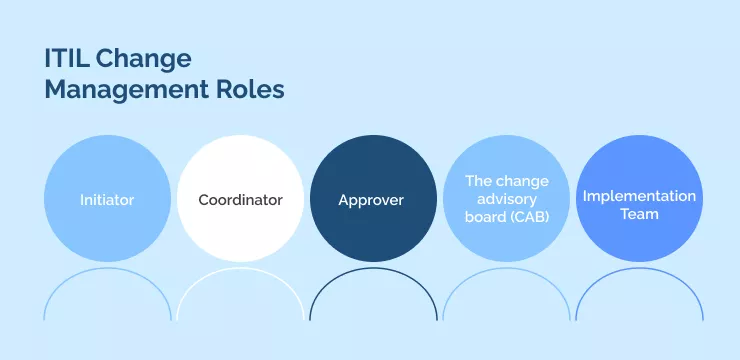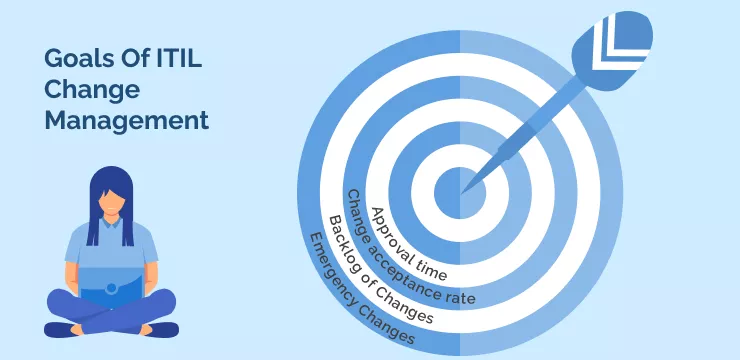
For technological change management, ITIL (Information Technology Information Library) offers some of the best ways to understand and minimize risks involved in a digital change process.
IT professionals, including project Managers, Service Delivery Managers, Infrastructure Engineers, Scrum Masters, and Security Consultants, earn an ITIL certification to help them make sense of complex change processes. The protocols of ITIL define the typical change management process, provide ways of categorizing every proposed change, and clearly define the roles in a change management team.
ITIL can have a significant positive impact on organizational development and workflow in any aspect of IT. This article will introduce the key elements of ITIL change management, explaining how this proprietary framework can support digital transformation in complex organizations.
What Is The Information Technology Infrastructure Library (ITIL)?
The Information Technology Infrastructure Library (ITIL) provides an in-depth framework to manage the technical resources for large businesses. ITIL’s flexible guidelines allow organizations to get the best value out of their IT infrastructure.
The ITIL was first developed in the early 1980s as a collaboration between Axelos and the UK government. Since then, it has been updated to meet new challenges of the digital world, with major releases in 2001 (ITIL 2), 2007 (ITIL 2007), 2011 (ITIL 3), and 2019 (ITIL 4).
Although Axelos phased out training in ITIL 3 in 2021, many ITIL 3 processes are still current. ITIL remains a registered trademark of Axelos.
The ITIL framework attends to a vast range of services. ITIL 4 is divided into three areas: general management practices, service management practices, and technical management practices.
When they were transitioning from 3 to ITIL 4, Axelos advised that there were seven guiding principles:
- Focus on value
- Start where you are
- Progress iteratively with feedback
- Think and work holistically
- Keep it simple and practical
- Optimize and automate
ITIL 4 also seeks to operate closely with other management processes, like agile, IT4IT, and DevOps.
What Is ITIL Change Management?
Change management is just one set of practices within the broader ITIL framework.
The benefits of ITIL change management:
- Supporting organizations to make the best choices around change
- improve the ability to implement digital changes
- Facilitate continual service improvement
In practice, ITIL change management adds systemized scrutiny and bureaucracy to processes across a company. While this may mean that some changes take longer to control, ITIL frameworks reduce the overall time spent on changes and help to systematically improve service management.
As we will see, ITIL change management defines the nature of critical parts of the change process. That includes the classification of change, the approval process, and key performance indicators. Although the ITIL guidance for the change management process can sound prescriptive, it is designed to be flexible. It fits comfortably with many different kinds of organizations.
In ITIL 4, change management is known as “change enablement.”
The Core ITIL Change Management Process Flow
The ITIL change management process standardizes the initiation, approval, and delivery of change requests. Large organizations may have change requests for IT services from many business units. A standard process flow ensures that change managers can easily understand the current demands facing the organization’s digital strategy.
Request for change (RFC)
The RFC is a crucial document that presents vital information about the proposed change. The change initiator must explain the schedule, budget, priority, and risks involved, among other information. Many organizations use a standard RFC template to submit all requests accurately.
Change Assessment
Different types of change requests lead to different kinds of assessment. Minor changes only require approval from the change manager. More extensive changes will go to the change advisory board.
Changes in the ITIL guidelines have made the process more flexible. ITIL 2011 suggested that the business must produce a change evaluation report. However, In ITIL 4, change managers have more freedom to structure processes aligned with business priorities.
Change Deployment (or Change Implementation)
ITIL processes do not intervene in the specific methods of deploying a digital change. When the change management team has agreed that the change needs to occur, the project is handed over to the release and deployment team. The RFC should include contingency planning as part of its risk assessment, which helps support the practical implementation.
Change Closure and Post-Implementation Review
After the change implementation team has finished rolling out the new service, the ITIL process flow kicks in. The change management team then checks that the correct paperwork has been completed along the journey, discovers whether the change has been successfully implemented, and decides whether the outcome is satisfactory.
Like the start of the ITIL process flow, the change closure and post-implementation review often use the same document templates across an organization. A standardized review process helps to avoid implementation failure in the future.
The change closure is another administrative procedure. Small organizations might not see the benefit of this “red tape.” But in larger business operations, checking that everyone is operating suitably helps to implement continual service improvement for all business operations.
ITIL Change Management Categories
The categories for change are one of the most valuable lessons from the ITIL change management procedures. All organizations can use these categories to understand their change processes better.
The ITIL framework offers three categories: standard changes, normal changes, and emergency changes. Within ITIL change management, each type leads to a slightly different management process.
Standard Changes
Standard changes are small changes with small budgets, low risks, and manageable implementations. These minor changes are so small that they aren’t subject to the same change process as others. For standard changes, initiators do not need to submit a request for change (RFC). Examples of standard changes include OS upgrades, modular add-ons, and patch upgrades.
Normal Changes
Any plan to introduce normal change (or non-standard change) starts a significant administrative process. A normal change requires a detailed RFC, which will require clearance from the change advisory board. Any substantial change to IT infrastructure involves this kind of clearance.
Some organizations use further categories for normal change, including major change, minor change, and significant change.
Emergency Changes
Sometimes, IT challenges arise that require swift implementation. The ITIL change management process categorizes sudden and unplanned changes as emergency changes. In emergencies, the change request may be processed after the implementation. In IT, a crisis will be linked to serious problem management, such as a major data breach.
A 2021 Gartner survey predicted that up to 30% of important IT infrastructure providers will experience data breaches before 2025. Security risks will remain a serious part of the digital landscape for a long time to come. ITIL change management offers a framework to meet those challenges.
Change priority
All proposed changes are categorized as standard, normal, or emergency. In addition, some organizations will also apply a priority level at low, normal, high, or critical. These categories help to decide the pace of decision-making and communication.
Impact category
The impact category gives further guidance about the decision-making process.
The change manager is responsible for the decision alone for a marginal impact. When the impact is substantial, the change advisory board works with the change manager to reach a decision. And for a critical impact, the change advisory board and IT management work together to decide how to implement a change that could affect many processes.
ITIL Change Management Roles
ITIL helpfully defines several roles in change management. An organization that uses the principles will have named staff dealing with every stage of the IT change management process.
Initiator
The initiator of a change request will have a first-hand understanding of the problems employees face. The initiator identifies a digital need, starts the process by submitting an RFC, and works with service staff to implement a successful change.
Coordinator
The change coordinator is the go-to contact for any change that arises from incidents, emergencies, problems, or other unexpected situations. They have the knowledge and understanding to create a clear implementation plan, providing invaluable input to an RFC.
Approver
Approval for a change request will vary according to the type of change sought. In some cases, the change manager can take individual responsibility for approval. In others, they will work with the change advisory board (CAB) or with IT management staff.
The change advisory board (CAB)
The CAB is one of the most influential groups in the ITIL process. The CAB will be made up of key stakeholders from around the organization. They meet in person for high-impact requests to decide how to handle them.
Implementation Team
The implementation team manages the technical steps of implementing an approved change. The overall ITIL change management process only partially governs the work of an implementation and deployment team.
Goals Of ITIL Change Management
Using the ITIL framework to supervise IT change management produces a lot of information that helps to monitor success. Success in ITIL includes the effectiveness of the process, as well as the value of the outcome. Some KPIs of ITIL change management included approval times, successful change requests, backlog of changes, and the number of emergency changes.
Approval time
Change initiators know that they cannot always have instant approval. However, if change requests persistently take too long, the organization may need to revise its approach to digital transformation.
Change acceptance rate
The change acceptance rate compares the successful changes to the number that have been submitted. The figure tells a valuable story about attitudes toward digital transformation. If users submit many requests that do not meet change approval, the CAB may have a different understanding of the organization’s digital strategy compared with initiators.
As such, a business that tries to maintain detailed records about change acceptance will be able to establish standard procedures and promote a clear vision for the company’s IT service.
Backlog of Changes
The backlog of changes should remain the same over time. There will always be some change requests waiting to go through the approval process, depending on the availability of the change manager or the change advisory board. All the same, staff must be assured that their requests will be dealt with within a set period.
Emergency Changes
Although no organization wants crises, ITIL helps to manage problems whenever they arise. Monitoring the number of emergency change deployments can be useful in assessing the effectiveness of the overall change program. If users use the emergency change process too often, initiators may try to bypass the system for normal change. On the other hand, if no one requests emergency changes, staff may not understand how this change can help.
Integration With Supplementary ITIL Models
One of the innovations in ITIL 4 is an emphasis on integration with other models of management.
Change Management and CMDB
The Configuration Management Database (CMDB) is an inventory of all a company’s digital assets, with information about their connections and relationships. The CMDB means that existing IT assets are fully visible. When an emergency change has to happen, the CMBD can quickly help identify its impact on other systems.
For any non-standard change, the CMDB provides important resources for continuity management.
Change & Release Management
A Release management process needs to understand the long-term goals of the company. The ITIL change management process provides excellent structures to provide planning, deployment, and review in an efficient manner.
Incident Management
Unlike managing releases, incident management operates on a concise time frame. Change management in ITIL directly supports incident management by clearly categorizing different kinds of change. If a critical piece of hardware needs replacing right away or a security upgrade must be installed this week, ITIL ensures that there is an appropriate process for helping these changes occur.
How To Create A Request For Change
Any normal change requires an RFC. An RFC can be created by an individual or on behalf of a particular business unit. It should include:
- The date of creation and submission
- Information of the change owner and change initiator
- Resources required for the implementation
- A budget and further financial information
- A schedule for the implementation
- Risk assessment
- Change priority
The size of a change request will vary according to the scale of the proposed activity. Major changes with a critical impact will require extensive supporting documentation. But requests for smaller non-standard changes will not require endless paperwork.
The Review Process in ITIL
Best practice in ITIL change management relies on an excellent review process. The required change category supports managers in applying the right level of scrutiny to the application.
- Only the manager in charge must sign off on the request for standard changes.
- A request for a normal change may be reviewed by one or more of the change managers, the CAB, and the IT management staff, depending on the perceived impact of the change.
- Emergency changes may need the approval of the emergency change advisory board. In some cases, the review can be conducted retrospectively.
One of ITIL change management’s upsides is how it carefully differentiates between different types of changes.
The Scope Of ITIL Change Management
ITIL is a great way of delivering consistent results for digital adoption in complex organizations. This article has shown a wide scope, covering service solutions, management information systems and tools, technology architectures and management architecture, processes, measurement systems, and methods and metrics.
ITIL does, however, have some limitations for change management. The framework won’t work in every organization. Some of its limitations include:
- The ITIL change management process only covers IT processes. Although it is excellent for digital transformation plans, it cannot be generalized to the full range of organizational change management demands.
- ITIL change management processes can be efficient, thorough, and effective. But if they are badly implemented in an organization, they can be time-consuming and costly. Best practices are fundamental.
- ITIL is a great way to efficiently standardize change processes for large organizations. These procedures might be a needless burden for smaller companies.
- If the ITIL process flow is mandated for all changes, it can be discouraging for third parties.
Many organizations rely on ITIL change management to improve their systems. But any business should reflect carefully before asking an ITIL professional to support their digital transformation.
ITIL Change Management Checklist
An organization’s ITIL change manager should already be familiar with ITIL processes. To achieve best practices, anyone participating in IT should remember the following:
- Regarding digital transformation, readiness for change is often about staff attitudes and commitments. ITIL change management process will be effective when the staff understands how it works. So make sure that all users know what they are doing and why they are asked to do it.
- To embed ITIL practices, take a personal interest in the documentation behind every change. Is every change adequately recorded and managed?
- Make sure that anyone initiating a change understands the requirements of the request for change (RFC). Templates can be beneficial.
- Risk management should be one of the central components of the process, but users can often let this slip.
- Identify the key performance indicators for the change management process, and communicate them clearly to imitators and deployment staff. The ITIL KPIs tell some exciting stories about digital change management.
ITIL Certification is an Investment in Digital Transformation
ITIL is one of many ways of handling digital transformation. However, it is a flexible and widely-understood system that can benefit large organizations. A 2021 Mckinsey report showed that organizations with excellent tech structures were also excellent at developing IT staff. As such, companies with high digital aspirations should encourage IT leaders to obtain ITIL certification.
ITIL-informed decision-making adapts easily to integrate with other approaches to digital transformation. For example, it could integrate with a digital adoption platform to take users through the entire experience of using new technology.
WalkMe Team
WalkMe spearheaded the Digital Adoption Platform (DAP) for associations to use the maximum capacity of their advanced resources. Utilizing man-made consciousness, AI, and context-oriented direction, WalkMe adds a powerful UI layer to raise the computerized proficiency, everything being equal.








